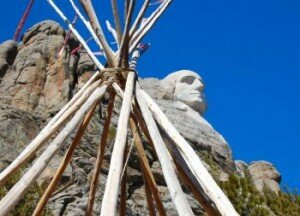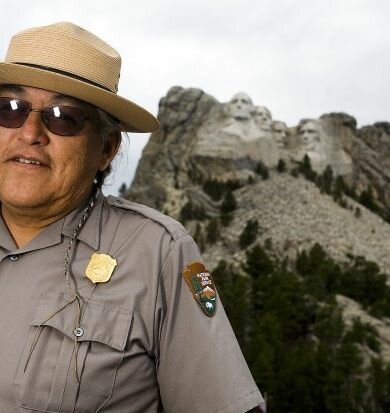A man of great vision departs Mount Rushmore Memorial
Talk About Race — By Tim Giago (Nanwica Kciji) on April 19, 2010 at 08:01Gerard Baker, a member of the Mandan/Hidatsa Tribe of the Fort Berthold Reservation in North Dakota, is a man of vision. And yet he is vilified by those white people who know nothing about the history of the Black Hills of South Dakota.
When Baker was appointed as Superintendent of the Mount Rushmore Memorial he saw the faces of four white presidents carved on the mountain. But he saw those faces through the eyes of an Indian. He chose not to diminish the glow that history has bestowed upon George Washington, Abraham Lincoln, Thomas Jefferson, and Teddy Roosevelt, but to add to that luster by introducing elements of the Native people who preceded the Memorial by centuries.
Very quietly, but with dignity, Baker began introducing elements of the Native culture and traditions to the Memorial. He had several tipis constructed near the site and introduced Native speakers to talk to the tourists and visitors about the history of the Hills and of the region. Aside from having the opportunity to view the sculpted faces of the four presidents, the visitors to the Memorial soon flocked to hear the Native speakers and to look at the other Native art and artifacts brought to the Memorial by the Lakota and other tribes of the Northern Plains.
The Native speakers and exhibits soon became two of the most popular features at the Memorial much to the chagrin of many white residents of Rapid City and the surrounding region. These are our Hills and our presidents on display and the Indian things Baker is bringing to the Memorial do not belong there, was the biggest and probably the most ridiculous complaint.
When Baker was re-assigned to be the first ever Assistant Director for Indian Relations for the National Park Service, a post the NPS recognized as extremely important, the reaction by the local partisans was as expected. Wrote Scott Odenbach of Spearfish, S. D. in the local daily, “Native American cultural diversity rather than the Memorial’s intended purpose: celebrating the lives and ideals of Washington, Jefferson, Roosevelt and Lincoln,” seemed to be the main focus of Superintendent Baker. On Baker’s new assignment Odenbach wrote, “Isn’t this an example of the job description finally catching up with the job functions performed?”
Wrote James Reichert of Rapid City, “That’s great! Now maybe we can keep Mount Rushmore safe from terrorist activities. And can we ask his replacement to move the tipi down the road to the Native American monument? It is inappropriate for a superintendent to impose his personal values upon a national monument.”
We suppose Mr. Reichert was talking about moving the tipis to Crazy Horse Memorial, which is down the road and it is evident that he never once considered the proven fact that the Native exhibits are extremely popular with visitors to the Memorial and that the majority of Native Americans living in this region find the addition of these exhibits by Mr. Baker to be one of the best things that ever happened at the Memorial.
 The local white folks should have known that Mount Rushmore was sculpted even while the ownership of the very land where it stands was involved in litigation between the United States and the tribes of the Great Sioux Nation. In other words, the United States allowed Gutzon Borglum to carve on the mountain while the land was a part of a lawsuit to determine ownership. About the illegal taking of the Black Hills by the United States, Supreme Court Justice Harry Blackmun wrote, “A more ripe and rank case of dishonest dealings may never be found in our history.”
The local white folks should have known that Mount Rushmore was sculpted even while the ownership of the very land where it stands was involved in litigation between the United States and the tribes of the Great Sioux Nation. In other words, the United States allowed Gutzon Borglum to carve on the mountain while the land was a part of a lawsuit to determine ownership. About the illegal taking of the Black Hills by the United States, Supreme Court Justice Harry Blackmun wrote, “A more ripe and rank case of dishonest dealings may never be found in our history.”
After the whining dies down and after all is said and done, Gerard Baker, will be admired and respected by not only the Native Americans of this region, but also by thousands of non-Natives, as the single most important superintendent ever to grace that job position at the Memorial. He had the vision to see beyond the racial prejudice that has permeated this region for more than 100 years and to implement the Native culture and traditions into the daily activities at the Memorial in hopes of opening a new sensitivity of this regions diversity, but by also creating an atmosphere of mutual respect and understanding between all races.
Racism, clear and simple, is behind the public vilification of a great man for having the vision and better yet, the authority to do something that should have been done 50 years ago.
Mount Rushmore is a better place because of Gerard Baker and I hope that the implementation of his vision will be continued by his replacement so that when the Native children from the surrounding reservations make their school trips to the Memorial, they will continue to see the exhibits and listen to the voices of the Native speakers reminding them that they were here first and no one can take that away from them.
Photo by Kristina Barker/Rapid City Journal
Tags: Gutzon Borglum, Justice Harry Blackmun, Mount RushmoreAuthor: Tim Giago (Nanwica Kciji) (34 Articles)

Tim Giago, an Oglala Lakota, is the editor and publisher of Native Sun News. He is the founder and first president of the Native American Journalists Association. He was a Nieman Fellow at Harvard with the Class of 1991. He was inducted into the South Dakota Newspaper Hall of Fame in 2008. His latest book, “Children Left Behind” is available through [email protected].



 Share This
Share This Tweet This
Tweet This Digg This
Digg This Save to delicious
Save to delicious Stumble it
Stumble it





 Why the US owes Haiti billions – The briefest history
Why the US owes Haiti billions – The briefest history Judith Butler refuses award at Berlin Pride citing racism
Judith Butler refuses award at Berlin Pride citing racism Finally, a national conversation on race
Finally, a national conversation on race







